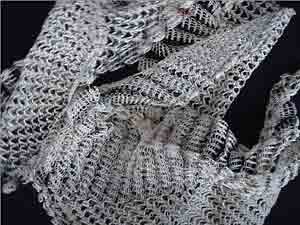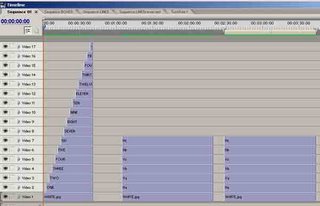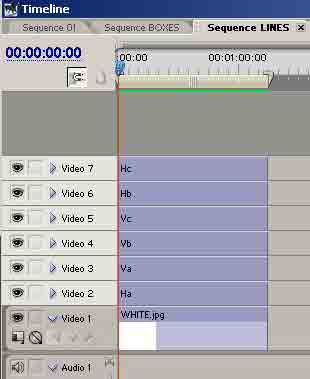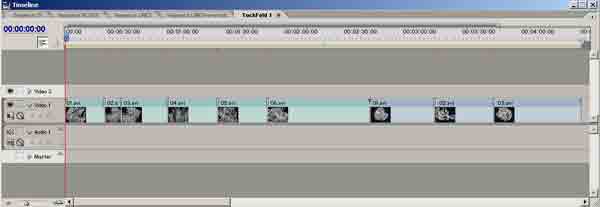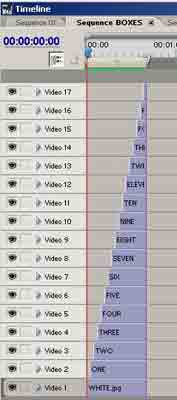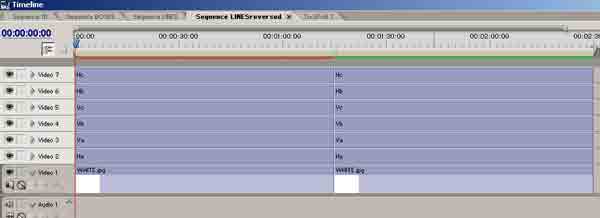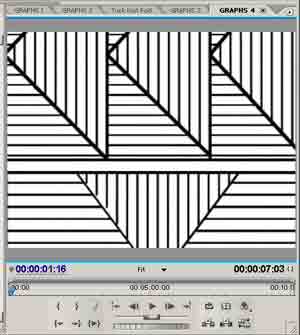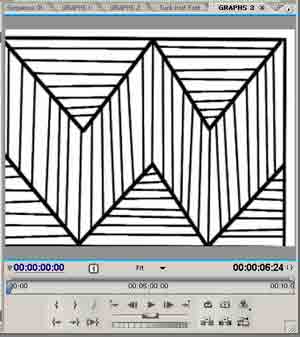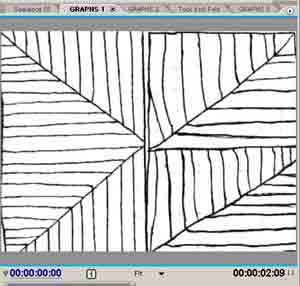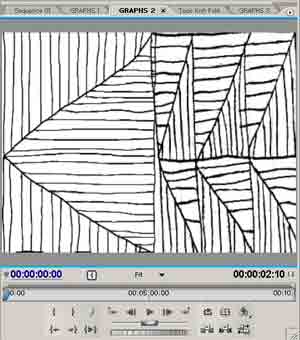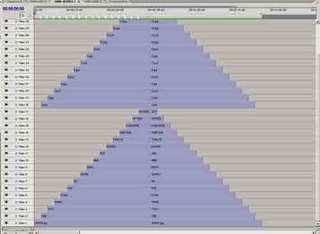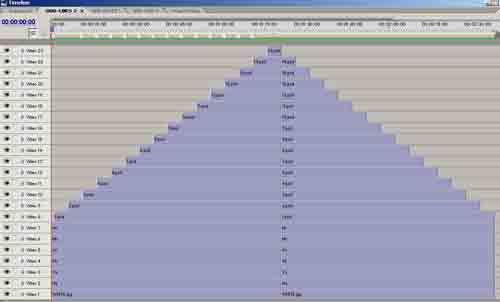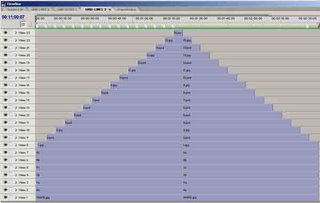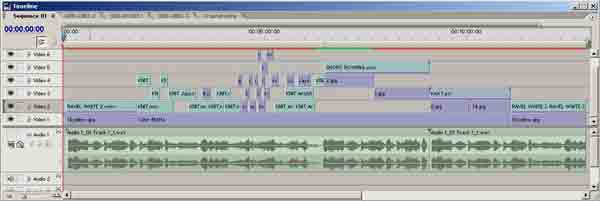Thursday, June 29, 2006
There is a Time to Reap and a Time to Sow
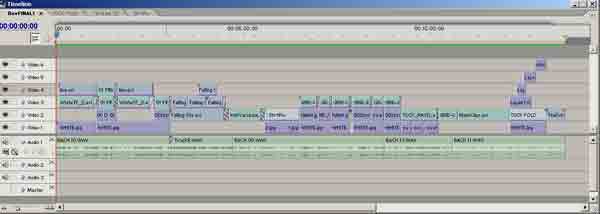
In an effort to convey the complexity of the video edits that comprise the compilation of this project, I have taken a number of screen grabs of the Time Lines of each of the component sections. Some of these sections also include grabbed images of the Monitor Window which serve to illustrate the time line clips. This is the Time Line of the Final DVD.
Wednesday, June 28, 2006
LABELS AGAIN
What is the purpose of a label? It is to inform, elucidate and illuminate the work for the benefit of enlightening the viewer. A label should be an adjunct to the work and not a replacement. The role of the label is to support the work and not to serve as an ‘in-your-face’ visual cacophony to supplant it, and that only serves to startle and confuse the viewer.
This occasion of labelling the work has become an opportunity to instigate a marketing ploy, of commercializing the work. The interjection of sign-posting is seriously misjudged in my opinion. To institute label designs as a blanket enterprise to all the installations in this exhibition is an affront, an insult to the artist and calls into question the integrity of the work on display. They are often not related to the work in mood, technique and context.
I have faith that my work can stand on it’s own two feet and does not need recourse to an unsympathetic label to ‘attract the punters’.
I am very glad that I shall be able to provide my own labelling for my work that will be more in keeping with the thrust of my intentions.
This occasion of labelling the work has become an opportunity to instigate a marketing ploy, of commercializing the work. The interjection of sign-posting is seriously misjudged in my opinion. To institute label designs as a blanket enterprise to all the installations in this exhibition is an affront, an insult to the artist and calls into question the integrity of the work on display. They are often not related to the work in mood, technique and context.
I have faith that my work can stand on it’s own two feet and does not need recourse to an unsympathetic label to ‘attract the punters’.
I am very glad that I shall be able to provide my own labelling for my work that will be more in keeping with the thrust of my intentions.
AS THE SHOW LOOMS, DISASTER STRIKES
Wouldn’t you know it! Sadly my computer went totally awol last night. Somehow [and I don’t know how] the machine got corrupted ! [all the extensions for all the programs [.exe files] were incredibly converted to .ink and I could not open or run anything! I have no idea what happened to cause that! Wouldn't you know it!] So I have spent the day recovering what I could.
Firstly I thought was that I have Acronis [a highly regarded backup program] which I had used to make a full backup of my C:\ drive, and this would save my bacon... sadly set of 8 rescue floppy discs froze on me!
O.K. Back to my old saviour....Norton Ghost. I had most of my [college] work on my second hard drive, which, thankfully, was not affected...
Strangely, although I could open the drives and move the files around, I couldn’t use any of the program, nor could I connect to the Internet. I did manage to burn some of my college work off the second drive onto a CD for the assessment on Thursday, Additionally, I did manage to salvage some crucial current information that I had stored as .doc files in ‘My Documents’ but... as for the rest ?????
I re-installed my Norton Ghost backup from last November onto the C drive and it has worked!!!! [whew..breathes a sign of relief].
But it has taken most of the day. [Fortunately, I didn't install many new programs since then, and so have managed to salvage most of the 'stuff' now.] So, onwards and upwards as they say.
My other problem is that the source stuff I used... is way larger than any CD/DVD... any ideas? Or do you want to see that too? I've done some screen grabs of the time lines from the video editing software and burned them onto the CD.... will that do?
I also have quite a lot of backup technical research which is in folders... I can bring that in as well....plus some CD's of my digital images...etc.etc.etc...
Re: Help for building the show… Yes, Steve [my friendly professional carpenter,] would be much happier coming in on Saturday [as he is in gainful employment and that’s not easy to come by these days…and I think he is quite keen to help [I've promised him a customized cashmere jumper....I am not without resources?] If this is not possible, he might be able to get a day off on Monday to help, but possibly not. However, in the interim, another friend has VOLUNTEERED [even] to come down from Birmingham to help as well. He can come on Monday and I've emailed him our Health and Safety form to fill out. He will be able to sign it, scan it in and email it back to me so I should be able to bring it along anon.
The one comforting thing that has happened just recently is that I will be able to make my own label for my work.
Firstly I thought was that I have Acronis [a highly regarded backup program] which I had used to make a full backup of my C:\ drive, and this would save my bacon... sadly set of 8 rescue floppy discs froze on me!
O.K. Back to my old saviour....Norton Ghost. I had most of my [college] work on my second hard drive, which, thankfully, was not affected...
Strangely, although I could open the drives and move the files around, I couldn’t use any of the program, nor could I connect to the Internet. I did manage to burn some of my college work off the second drive onto a CD for the assessment on Thursday, Additionally, I did manage to salvage some crucial current information that I had stored as .doc files in ‘My Documents’ but... as for the rest ?????
I re-installed my Norton Ghost backup from last November onto the C drive and it has worked!!!! [whew..breathes a sign of relief].
But it has taken most of the day. [Fortunately, I didn't install many new programs since then, and so have managed to salvage most of the 'stuff' now.] So, onwards and upwards as they say.
My other problem is that the source stuff I used... is way larger than any CD/DVD... any ideas? Or do you want to see that too? I've done some screen grabs of the time lines from the video editing software and burned them onto the CD.... will that do?
I also have quite a lot of backup technical research which is in folders... I can bring that in as well....plus some CD's of my digital images...etc.etc.etc...
Re: Help for building the show… Yes, Steve [my friendly professional carpenter,] would be much happier coming in on Saturday [as he is in gainful employment and that’s not easy to come by these days…and I think he is quite keen to help [I've promised him a customized cashmere jumper....I am not without resources?] If this is not possible, he might be able to get a day off on Monday to help, but possibly not. However, in the interim, another friend has VOLUNTEERED [even] to come down from Birmingham to help as well. He can come on Monday and I've emailed him our Health and Safety form to fill out. He will be able to sign it, scan it in and email it back to me so I should be able to bring it along anon.
The one comforting thing that has happened just recently is that I will be able to make my own label for my work.
Saturday, June 24, 2006
Westminster Photography BA Brick Lane

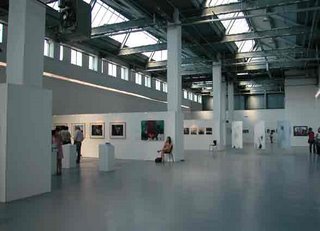
Why is it that photography shows now seem often to include Video projections? Is it the possibility of including sound linked to the presentation? There seems to be a prevailing necessity to have all visual work subsumed by the technology of the digital presentation.
The technical constraints of ‘chemical photography’ are quite different from the manipulative skills of a computer program. There is a sense of encountering the haptic quality of the paper and the magic of chemical transformations that is lost when reducing the image to a digital manipulation on a monitor.
I know that, by definition, photography is ‘painting with light’ but the real magic comes to transferring the visual image to the reality of paper and pigment by chemical means.
Paul Virilio, however, claims that photography lies, in that it captures ‘the moment’ whereas reality is in constant flux and time passing. Perhaps it is this feeling of the necessity of conveying the notion of ‘time passing’ that drives the artist towards the video representation?
Lev Manevich has something to say about the difference between the ‘analogue’ and the ‘digital’.
Digital reduces the image to a mathematical formula which is finite, but analogue retains a sense of the infinite. An object can be defined and manipulated algorithmically, whereas analogue images are truly ‘continuous’.
I found the space of the gallery wonderful, but sadly the images did not really fill this space…betraying its’ promise! There were the usual attempts to discover ‘identity’ or to portray the current dynamics of their world [the pop scene, nightclubbing etc].
The most beautiful series of images was by Siobhan Doran who had produced a book of images based on the now defunct Midland Grand Hotel St. Pancras. These exhibited not only a skill full eye in selecting the image, but a commensurate ability to print up these images! The book was enhanced by a brief narrative which held the images together well and gave a sense of carefully constructed framework to the presentation.
Another series of very evocative images was presented by Jessica Begault. The series was of people looking out of windows at the ‘world outside’, taken from inside the room. The people were in shadow and the rectangle of the window was the one bright area of the image. In composition, they were carefully arranged and managed to elicit a feeling of considered contemplation. They were, somehow poignant and thoughtful, in contrast with the more strident and glaring photos of pop scenes and modern culture that were around them.
KINGSTON ARCHITECTURAL DEGREE SHOW, Brick Lane
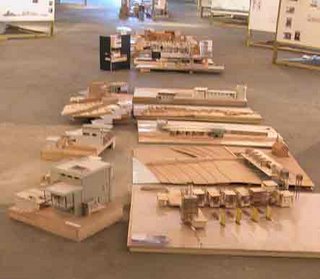
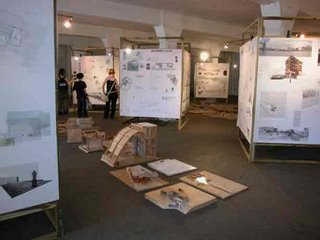
Earnest young men…. not overly enthusiastic about reverencing the use of computers to design living spaces… but committed to environmentally friendly constructions. Now these youngsters are entering upon a fiercely competitive enterprise armed only with the conviction that has been drummed into them over the past three years at college to build sustainable architecture. But what does that mean? Their livelihood depends on the recycling and renewing of the structures around us. It is notable that London is being consistently torn down and rebuilt. Often there is very little to distinguish the new from the old. Is it really cheaper to pull down entire edifices in order to rebuild much the same sort of spaces?
It is claimed that the old interiors are no longer compatible with new specifications and in order to renew windows, doors etc, they would have to be purpose built rather than conforming to present day modules and measurements. So, pull it down and re-build. Talk about planned obsolescence!
But the graduates I spoke with claimed they preferred to draw their plans out by hand rather than relying on the computer to assist their design strategies. They said that drawing by hand gave them time to think and reflect on their work, rather than fall victim to the ease with which mistakes can be corrected and erased on a computer.
It was a question of injecting the possibility of contemplation and consideration of their work… a note of criticality rather than speed. After spending some time in the baroque atmosphere of Budapest, I found this display austere and rather antiseptic? Perhaps it isn't easy to make models of wedding cake icing out of cardboard and Balsa wood?
BUDAPEST
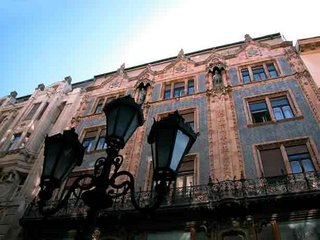
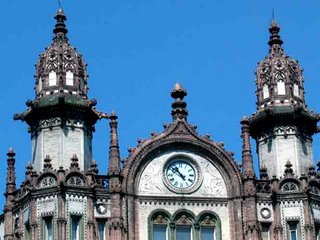
The heat nearly defeated me! The forecast was for rain, showers, and overcast. It was blisteringly hot with no respite in sight!
I walked… that’s the best way to get a feel of the place isn’t it?
The big change from London, was the superabundance of shoe shops and the lack of fast food joints!
The Hungarians eat well…. very well… almost too well.
I could only manage two meals a day. Was it from the heat, or the fact that an evening meal for one was really more than enough for two!
The first impressions were of grey damaged buildings interspersed with painfully ugly utilitarian but deadened communist architecture.
It appears that the Nazis [on the hill in Buda] and the Russians, across the Danube, on the flat plain of Pest, bombed the hell out of each other and all the surrounding buildings for three weeks at the end of the last war while a group of Nazi thugs [ The Arrow Cross] rounded up everyone else, brought them to the bank of the Danube and proceeded to shoot them all, then dump them in the river!
It must have been a horrific time! No wonder the city may appear grey and depressing with that sort of history behind it?
However, once you look through the curtain of recent events, to the end of the 19th century, you find examples of the most voluptuous, embellished architectural features.
It does give an insight into what went before and what was lost. Can it be regained?
The castle hill seems a lovely restful remove from the bustle of the business area of Pest, overrun with tourists of course! The Museums are well kept and accessible too.
The public transport is amazingly good and free for EU citizens over 65!
But, for me, without doubt were fleeting glimpses of the traces of staggeringly elaborate and intricately executed designs and architectural features of days gone by.
In retrospect, Budapest is definitely a place worth re-visiting in spite of the fact that I managed to take 250 photos this time! Hurray for Digital Cameras!
LCC BA DEGREE SHOW

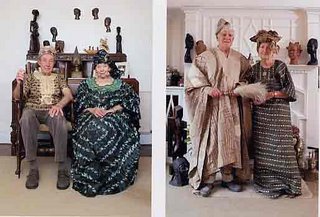
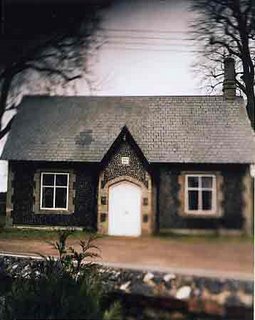
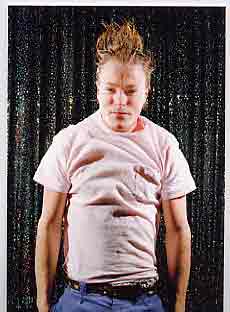
The Private View was on 13/06/06
This was a mixed show of graduate work… some evocative, some literal and some just plain eerie.
Favorite photos were by Caren Geary in a series called Catch Me Before I Fall.
These were large coloured portraits of various people in front of a beaded backdrop, who seemed to be ‘falling’ [or jumping?]
They were in focus, very well printed and technically well produced. They were examples of what can be achieved by careful staging in a studio, but did portray that significant moment when one is freed from the constraints of atmosphere and almost defies gravity… the moment of suspension. This is quite tricky to portray a significant isolated moment that transcends the barriers of normalcy.
Troy Bailey showed images of ‘New England’ houses that seemed more like Doll’s houses than real concrete spaces. This was helped by the technique of vignetting the images and presenting them as if viewing them through a peephole. Only the centre of the photo was in focus, and there was no evidence of human habitation, only the occasional telegraph wire indicated that these were not indeed mock-ups.
Katie Sheldrake exhibited a series of portraits of elderly couples staged in traditional English domestic settings, but dressed in what appeared to be ethnic costumes totally out of keeping with their appearance and surroundings. They were also surrounded by objects that were obviously collected on their outings to various third world countries in e.g. Africa.
There were some unmemorable family group portraits and a number of rather dramatic photos of abandoned, ruined buildings exhibiting signs, reminders of the humans that once inhabited these spaces by Melinda Gibson,Mi Jeong Baek and Hayley Caradoc-Hodgkins.
Monday, June 05, 2006
THOUGHTS & REFLECTIONS
The admonition as related to my work, not to be too descriptive can be, I feel, construed to be rather negative.
After all, the whole purpose of visual art is communication… illustrating and illuminating the text. I am wary of technical prestidigitation and sleight-of-hand visual trickery employed in order to seduce, or entertain without having recourse to a deeper and more significant engagement with intention.
Some observations that have occurred to me after the Drawing symposium:
The Digital Media can be used as a means of disseminating information and is therefore descriptive, illustrative, and narrative. However, it does require engagement and a certain amount of investment on the part of the viewer.
One might wonder if the ‘work’ entirely self-referential or is it ‘sharing’. Does it repay the investment made by the viewer? In what way does it relate to the viewer’s concerns?
With regard to introducing music to ‘fill out’ my visual presentation… I consider that some J.S.Bach pieces for the solo violin would be suitable.
There are a number of points that relate to the visual work.
The single strand of music is a metaphor for the single strand of yarn as it constructs the substrate. The sound is mellifluous and aurally replicates the folding, twisting and turning of the yarn. It is a single stringed instrument, but the sound it produces builds up until it culminates into a whole composition.
J.S. Bach was concerned with the construction of his music and reflected an interest in mathematics, just as the knitted samples refer back to grids and formulae.
For all these reasons, I think the music I propose to use is relevant.
I was considering using rhythmic drumming loops to emulate the noise and cacophony of the knitting machine, but I rejected this concept as being too descriptive and particular. After all, it is the fabric that I am interested in, and not just the means of production.
After all, the whole purpose of visual art is communication… illustrating and illuminating the text. I am wary of technical prestidigitation and sleight-of-hand visual trickery employed in order to seduce, or entertain without having recourse to a deeper and more significant engagement with intention.
Some observations that have occurred to me after the Drawing symposium:
The Digital Media can be used as a means of disseminating information and is therefore descriptive, illustrative, and narrative. However, it does require engagement and a certain amount of investment on the part of the viewer.
One might wonder if the ‘work’ entirely self-referential or is it ‘sharing’. Does it repay the investment made by the viewer? In what way does it relate to the viewer’s concerns?
With regard to introducing music to ‘fill out’ my visual presentation… I consider that some J.S.Bach pieces for the solo violin would be suitable.
There are a number of points that relate to the visual work.
The single strand of music is a metaphor for the single strand of yarn as it constructs the substrate. The sound is mellifluous and aurally replicates the folding, twisting and turning of the yarn. It is a single stringed instrument, but the sound it produces builds up until it culminates into a whole composition.
J.S. Bach was concerned with the construction of his music and reflected an interest in mathematics, just as the knitted samples refer back to grids and formulae.
For all these reasons, I think the music I propose to use is relevant.
I was considering using rhythmic drumming loops to emulate the noise and cacophony of the knitting machine, but I rejected this concept as being too descriptive and particular. After all, it is the fabric that I am interested in, and not just the means of production.
Saturday, June 03, 2006
RCA DEGREE SHOW PHOTOGRAPHY EXHIBITION
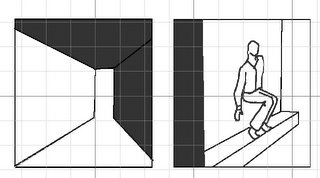
My initial responses:
The catalogue which consisted of expositions and interviews with the exhibitors was very interesting in view of our own projected ‘flyer’. It was beautifully presented in a Black Plastic bag [similar to those that come with Photographic Paper] and printed simply on substantial white paper. Each exhibitor had a folded section that included an interview or an Artists Statement that really clarified the work and two A4 reproductions of their work. It was very impressive, in a world where presentation contributes considerably to the integrity of the work.
1. Martin Clark: Semena Series: Postwoman / Runt / The Gospel [ landscape – Road – Preacher man standing in the winding road.] / Lady Boss. This series seemed to me to be evocative of a hidden narrative and triggered memories of stories told about rural small town USA and the kind of mythology that revolves around this notion; the insularity and social hierarchy that exists in a small town.
Virginia Litzler: Untitled / Amit / Cesure – large B&W prints of a single person against a wall, crouching.. Medium format Camera proportions.
The strength of these images lies primarily in their composition and graphic imagery. There is an inherent tension exhibited between the figure and the setting….the setting being monolithic and concrete, whereas the figure is captured in a moment of physical stress and poised like a spring.
2. Kirk Palmer: HD Video: ‘Murmer’.. of trees blowing in the wind with wind sound effects… The narrative builds slowly and is underlined by the increase in volume of the sound track. The pace is unhurried but the effect is mesmeric.
3. Peter Jacques: 12 Labours of Hercules: Pieces that are created with chemicals drawn onto photographic paper. He is concerned with writing and books… he is dyslexic. The work is difficult to ‘unpack’ and the significance of the marks defies explanation. As a viewer I ask, what has this to do with Photography or painting with light? It is very opaque and, in spite of being explicitly titled, it is only on reading the artists extended explanation in the catalogue that his intentions and methodology become clear.
4. Neil Wissnik: Pugwash. ‘Staged’ photos of an American ‘town’ in the evening. These are large colour C Prints of a town as evening draws in. The light is diffuse and fading thus rendering the scene dark and with an ominous tinge, as if something bleak has or will happen. The images are devoid of people. Why is this town deserted?
5. Brigida Mendes: disturbing photos [very large black and white] of pairs… old women / chairs / etc. The chairs are cut up and placed to give the print a symmetrical feel. There is something very unsettling about these images. They are not portraits but convey feelings of the even unevenness of these women’s lives. Furniture cut in half and composed to give an illusion of symmetry, without clearly being manipulated as mirror images.
6. Ben Young: Video ‘ The Sons of L’Homme Dore’… very surreal and influenced by science fiction. Story of a Crab, and a young man cavorting in the waves…. walking on snow / on bluebells / dancing [upside down] narrated by Brian Blessed. This video benefits from the voice-over narrative directing and explaining the sequence of images to the viewer. Although it initially begins with a series of unreal/surrealistic sequences, it then descends/degenerates into a more recognizable fantasy that relates to a contemporary action-based story of conflict between a giant crab and a young man by the seaside with a more traditional ending where the young man runs into the sea and swims out into the sunset….?
7. Wiebk Leister: Hals uber kopf- C Prints close up of a small child being tickled. These are dynamic, close cropped square images which are close-framed in simple black wood frames. I question the framing on these images? They seem to give them a claustrophobic feel? The proportion of the prints indicate they might well have been shot with a medium format camera which is used for good portraiture, but is not as immediate and instinctive as a smaller 35 mm S.L.R. So, although they seem to be spontaneous, they are more considered due to the awkwardness inherent in the use of the camera.
After these initial responses, I read the notes in the catalogue where considerably more of the artists’ intentions and process were revealed. I wonder now, how much the viewer is expected to tease out of what he sees and how much relies on the thoughts and revealed background to the work that is built-in by the artist?
The catalogue was a very impressive collection of single folded pieces of substantial card . Each one consisted of a printed text -an exposition or interview with the artist and two pages of selected images.
PHOTO LONDON 2006
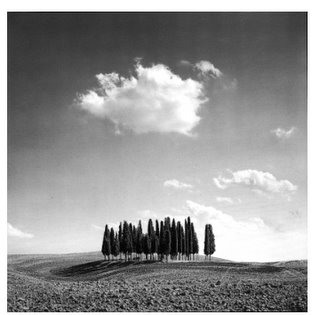
1. Images of birds… selected out and isolated. These are printed on transparent film which is then mounted on clear Perspex sheets. These are presented raised from a plain background… thus resulting in a shadow of the image projected onto the background.
2. Massimo Vitale: Italian photographer produces very large Colour prints of seaside scenes. Previous work has been of a well populated beach taken high up from a platform erected in the sea.
These pictures are taken from the land. The colour of the people is saturated, but the sea, sky, and rocks are ‘blown out’, washed out to a white tinged with a pale hint of colour! The sea and sky seem to be horribly overexposed! This must be done in the printing? or digital manipulation?
3. Juan Fontanive: ‘Paper Films’… a series of images on a bicycle wheel which is continuously turning… presenting the images like a ‘flip book’ . Another exhibit is of three boxes [see below] suspended; each rotating a series of images that cycle through…flipping.
These exhibits are ‘motorized presentations’ and can be seen at the Riflemaker Gallery.
4. Abelardo Morell – Chrysler Building: Very Large Black and White image projected upside-down on the wall of a hotel room through a small hole in the curtain… a long exposure taken overnight with a plate camera mounted on a tripod.
5. John Blakemore… Black and White images of Tulips.. Selenium toned.
6. Boyd and Evans: Photo Ink Jet Print [very large] of a bleak landscape. This was [volcanic?] a reservoir [in the U.S.] There were two colours of sandstone, but the background was black and white. The image must have been manipulated in Photoshop.
From ‘Between a Rock and a Hard Place’ a curated exhibition… ‘These works are a testament to the uncanny pull of rocks, the stillness, the divinity, the allure. These rocks and stones represent our landscaper, the exterior matter against which we define ourselves and each art work open up a dialogue between man and his orld, artist and landscape, object and representation of object.
7. Susan Derges: Ilfachrome Print… [reflections at night in pools of water].
a. ‘Shoreline’ graphite oil and water between two glass slides taken microsopically.
Lightjet prints: Lazar print on photographic paper.
8. Veronica Bailey: Prints of the edges of books [pages] blown up very big!
9. Tim Simmons: Photos taken at night of forest scenes with spotlight illumination.
10. Jean Miele: Black and White Landscapes taken using coloured filters to lighten the appearance of GREENs.!
11. Alexander Yakut: [Russian photographer] Photos of Samarakand taken at NIGHT… These are Black and White Photos with colour re-touching.
Some Final Strategies
When approaching my final project, I was inclined to think ‘less is more’ in regard to the execution of my video. I have always maintained that in the design of a knitted project, one should not attempt to knit a ‘people-shaped tea cosy’. By this, I mean that one should not throw every trick and design feature into one garment, at the cost of the overall impact of the piece.
It is really a question of avoiding the ‘over-egging’ of the cake. How many times have we seen an artist attempt to use one piece as a shop window merely for a display and affirmation of his skill and ingenuity only to fail lamentably as the piece appears overworked – over designed – and hopelessly mired in technique that subverts and detracts from the underlying concept.
Currently the timing of video sequences seems to have two agendas.
I think there has recently been a trend to divide clips into short sharp sequences of duration…. into lengths that last for seconds, or even frames.
One agenda seems to be heavily influenced by advertisements and has consequently overflowed into Hollywood-type actions sequences where the film consists of short rapid scenes/views/cuts from one sequence or part of clip to another.
Here the time line can be dictated by either:
1. The need to inject a dynamic into the narrative and build up the tension
or
2. The advertisers need to convey the information in the shortest possible time to create the necessary impact.
To be explicit: this technique is influenced by the imperative to introduce a dynamic element of action into the current run of action Movies and Computer Games. It is also a result of the advertising clips seen on TV and in the Movies. If the one of the primary constraints influencing the advertiser; that is, he must pay for his advert according to the time it takes to play it, then one can understand the compelling reason to impart as much information as possible in the shortest amount of time.
This technique can be seen to be employed in opposition move to the more lyrical movies of someone like “Where Is My Friend’s House “ by Abbas Kiarostami and, more recently, “Lemming” .by Dominik Moll, where atmosphere, not action is pivotal to the plot. The sequences seem, at times, to be painfully slow, underlined by a the sound track that is also slow, melodic, moody and mellifluous. At the end of the film, the conclusion / final outcome was very powerful, hauntingly beautiful and had an eyrie significance.
I am now thinking that the ebb and flow of a slower, more lyrical sequence of footage would be more appropriate to my subject matter which really concerns the gradual evolution of the knitted substrate and it’s subsequent folding and un-folding.
Another approach might be:
By developing the time line starting with the Audio track, which is often based on modern pop music with an overbearing ‘beat’, this leads to this kind of rapid cutting of the images, which are triggered, or married to this rapid insistent beat.
It is really a question of avoiding the ‘over-egging’ of the cake. How many times have we seen an artist attempt to use one piece as a shop window merely for a display and affirmation of his skill and ingenuity only to fail lamentably as the piece appears overworked – over designed – and hopelessly mired in technique that subverts and detracts from the underlying concept.
Currently the timing of video sequences seems to have two agendas.
I think there has recently been a trend to divide clips into short sharp sequences of duration…. into lengths that last for seconds, or even frames.
One agenda seems to be heavily influenced by advertisements and has consequently overflowed into Hollywood-type actions sequences where the film consists of short rapid scenes/views/cuts from one sequence or part of clip to another.
Here the time line can be dictated by either:
1. The need to inject a dynamic into the narrative and build up the tension
or
2. The advertisers need to convey the information in the shortest possible time to create the necessary impact.
To be explicit: this technique is influenced by the imperative to introduce a dynamic element of action into the current run of action Movies and Computer Games. It is also a result of the advertising clips seen on TV and in the Movies. If the one of the primary constraints influencing the advertiser; that is, he must pay for his advert according to the time it takes to play it, then one can understand the compelling reason to impart as much information as possible in the shortest amount of time.
This technique can be seen to be employed in opposition move to the more lyrical movies of someone like “Where Is My Friend’s House “ by Abbas Kiarostami and, more recently, “Lemming” .by Dominik Moll, where atmosphere, not action is pivotal to the plot. The sequences seem, at times, to be painfully slow, underlined by a the sound track that is also slow, melodic, moody and mellifluous. At the end of the film, the conclusion / final outcome was very powerful, hauntingly beautiful and had an eyrie significance.
I am now thinking that the ebb and flow of a slower, more lyrical sequence of footage would be more appropriate to my subject matter which really concerns the gradual evolution of the knitted substrate and it’s subsequent folding and un-folding.
Another approach might be:
By developing the time line starting with the Audio track, which is often based on modern pop music with an overbearing ‘beat’, this leads to this kind of rapid cutting of the images, which are triggered, or married to this rapid insistent beat.
Friday, May 26, 2006
Labelling - A Rant
I was very reluctant to interject a dissonant note concerning the discussion of labels, but I have deep misgivings about these. Although it might be considered inappropriate for me to cast aspersions on this project, I am extremely disturbed and unhappy about this label which, as I see it, is not at all relevant to my work.
Yes, I am convinced that there is a definite need for our Promotional Material to be well designed and as attractive, memorable and eye-catching as possible.
Yes, it is critically important that we have a clear logo which has dramatic and dynamic impact.
Design input should be confined to the logo, and any required promotional
material such as the label for the DVD and/or the flyer and Posters not to be appended to each individual's installation.
Every exhibition, gallery, or museum I have visited has had explanatory labels on White card with a black text which are clear, simple and legible, whose purpose is to convey crucial information regarding the presentation.
On the other hand, when I go to the shop to purchase a box of breakfast cereal or a container of juice, I quite expect to see colourful and descriptive packaging designed to differentiate the contents and promote the brand.
My work is neither a particular type of breakfast cereal nor a type of juice and I find the concept of attaching coloured labels deeply insulting. Coloured packaging is used to promote a brand and irrelevant to my work.
Therefore I am concerned that I should be obliged to put this kind of thing alongside my presentation.
You might say, I am not merely angry, I am incandescent about this matter.
Yes, I am convinced that there is a definite need for our Promotional Material to be well designed and as attractive, memorable and eye-catching as possible.
Yes, it is critically important that we have a clear logo which has dramatic and dynamic impact.
Design input should be confined to the logo, and any required promotional
material such as the label for the DVD and/or the flyer and Posters not to be appended to each individual's installation.
Every exhibition, gallery, or museum I have visited has had explanatory labels on White card with a black text which are clear, simple and legible, whose purpose is to convey crucial information regarding the presentation.
On the other hand, when I go to the shop to purchase a box of breakfast cereal or a container of juice, I quite expect to see colourful and descriptive packaging designed to differentiate the contents and promote the brand.
My work is neither a particular type of breakfast cereal nor a type of juice and I find the concept of attaching coloured labels deeply insulting. Coloured packaging is used to promote a brand and irrelevant to my work.
Therefore I am concerned that I should be obliged to put this kind of thing alongside my presentation.
You might say, I am not merely angry, I am incandescent about this matter.
Sunday, May 07, 2006
Literature and Art:
The literary work, the written word feeds the visualization process
The Sound and The Fury, by William Faulkner and Deleuze’s concepts of Monads and Rhizomes.
This book poses some interesting reverberations with the concepts that concern Deleuze. The manner of writing [stream of consciousness] was innovative and ground-breaking when Faulkner wrote this book in 1928, but it is still as problematic and challenging to the reader today as it was then.
Deleuze always maintained that his book Mille Plateaus, could be read in any order, and did not require the reader to ‘begin at the beginning, stop when he reached the end and leave the middle for in-between’ as Lewis Carol might say.
The reader, indeed was encouraged to dip into the book, hopping from one chapter to another in no particular order. The ideas unfolded and echoed within the chapters. References appeared and filled out information available in other sections of the book. It is a book to be read and referred to at different times during the constructing process.
Faulkner also structures time in this seemingly disordered way. The book is divided into four sections and the first one is written by Benjy who is a congenital idiot. The time sequence in this section is not linear, but skips and hops from one incident which occurs earlier in time to other incidents in different times without the benefit of explanation or labelling. This makes it very difficult for the reader to follow the narrative and make some order or sense from it. This mixing up of time and place continues throughout the book and the only textual indication is the use of italics. Often Faulkner does not employ punctuation in a traditional manner which adds to the ‘challenge’ of reading.
Why does this interact with digital developments? Although video presentations occur in a linear manner [unless an element of interactivity is present], the construction does not necessarily proceed according to Cartesian principles. The Time Line in a Video Editing program can be constructed in a rhizomatic fashion, layering footage and stills; reversing, stretching, twisting and turning them and, in general, superimposing a non-linear logic to the sequencing of the elements.
The Sound and The Fury, by William Faulkner and Deleuze’s concepts of Monads and Rhizomes.
This book poses some interesting reverberations with the concepts that concern Deleuze. The manner of writing [stream of consciousness] was innovative and ground-breaking when Faulkner wrote this book in 1928, but it is still as problematic and challenging to the reader today as it was then.
Deleuze always maintained that his book Mille Plateaus, could be read in any order, and did not require the reader to ‘begin at the beginning, stop when he reached the end and leave the middle for in-between’ as Lewis Carol might say.
The reader, indeed was encouraged to dip into the book, hopping from one chapter to another in no particular order. The ideas unfolded and echoed within the chapters. References appeared and filled out information available in other sections of the book. It is a book to be read and referred to at different times during the constructing process.
Faulkner also structures time in this seemingly disordered way. The book is divided into four sections and the first one is written by Benjy who is a congenital idiot. The time sequence in this section is not linear, but skips and hops from one incident which occurs earlier in time to other incidents in different times without the benefit of explanation or labelling. This makes it very difficult for the reader to follow the narrative and make some order or sense from it. This mixing up of time and place continues throughout the book and the only textual indication is the use of italics. Often Faulkner does not employ punctuation in a traditional manner which adds to the ‘challenge’ of reading.
Why does this interact with digital developments? Although video presentations occur in a linear manner [unless an element of interactivity is present], the construction does not necessarily proceed according to Cartesian principles. The Time Line in a Video Editing program can be constructed in a rhizomatic fashion, layering footage and stills; reversing, stretching, twisting and turning them and, in general, superimposing a non-linear logic to the sequencing of the elements.
